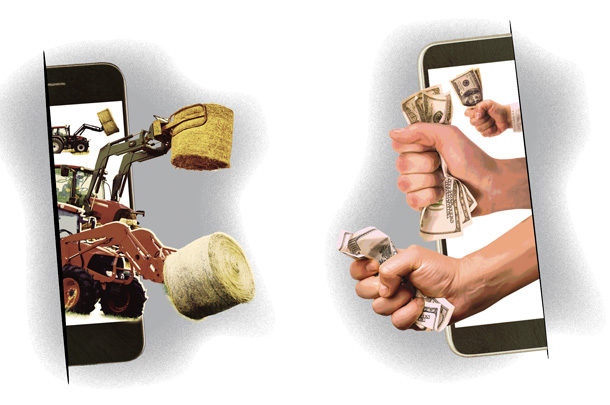Like the rest of agribusiness, hay commerce has been touched by digitalization – specifically the internet. More frequently, we see buyers and sellers meeting over platforms like Craigslist and even Facebook as opposed to the traditional local classifieds. This has offered producers and buyers some great benefits, allowing a broader range of opportunities and more efficient modes of business.
To accommodate the growing online hay market, AllHay.com was established to offer a hay-specific platform for producers, buyers and brokers to congregate safely and do business online. For a small fee, their customers can access inventory from their region or many states away, to find the right buyer or seller.
Besides offering commerce, AllHay.com says they have market data that can be a valuable tool for decision-making with the development of their HayMarket Analytics dashboard, which will show drought data, up-to-date market activity, cattle-on-feed as well as hay price prediction model.
The predictive model, explains AllHay.com representative Tanner Reed, utilizes 150-plus data points to accurately predict alfalfa price tops and bottoms six weeks out. He shares with Progressive Forage some insights into how and why the hay business has been impacted by digitalization.
How has the business of buying and selling hay changed in recent years?
REED: As the use of mobile phones for business has increased, so has buying and selling hay online. Over the past several years, the percentage of users accessing our platform from mobile phones has gone from about 35% up to 67% in 2020-21.
What hasn’t changed is the fact that this is a relationship business. We believe doing business online should enhance a hay producer’s in-person business relationships.
What are the benefits and drawbacks of using the internet to buy and sell hay?
REED: For producers, selling online means access to a larger pool of buyers year-round. For hay buyers, this means access to hay and forage regardless of the weather in your area.
The challenges are the same as always. When doing business online, you must verify the trustworthiness of the counter-party. We’re working to alleviate this concern with escrow options to create fair terms for both parties.
How can hay sellers make the most of online platforms? How do they make their product stand out and reach the right buyers?
REED: Take better pictures of your hay and get your hay tested. When a buyer is browsing hay on their phone, the picture of your hay is the first thing they’ll see, and it’s the reason they’ll click to learn more about your product.
Beyond that, the best thing you can do is answer your phone and stick to the terms you agreed on. You’ll likely find your best repeat customers online, but only if your product is as described and your terms are met. This includes making your shipping expectations clear upfront. Producers who do the basics right will stand out among the crowd.
What advice do you have for hay buyers browsing and purchasing online?
REED: At the time of this interview, AllHay has three to four times as many buyers as we do producers. Buyers should take the time to find a producer that works well with their operation, but be respectful of their time as well.
Reach out to multiple producers, even if the listing is a few months old (they may have a newer cutting that isn’t listed) – and if you start a conversation with a producer, be sure to reply in a timely manner. This should happen even if you don’t ultimately buy from that producer.
Should the state of the hay market influence how buyers and sellers find each otherand conduct business?
REED: I don’t know if it should, but it certainly does. As weather conditions change, buyers tend to look for alternative sources of hay just as producers go online to find new markets for their product.
The internet makes the world smaller. Both producers and buyers should consider their online reputation just as they consider their in-person reputation. Our belief is: By leveraging new communication platforms, we can improve the hay industry for everyone, regardless of the current state of the market.












